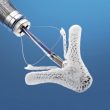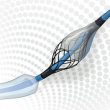Courtesy of Dr. Carlos Fava. Carotid artery disease is an important cause of stroke and is associated to coronary artery disease. When patients need myocardial revascularization surgery (Carotid Artery Bypass Graft) and cannot wait one month or more for carotid revascularization, the optimal management strategy is still controversial. The aim of this study was...
Critical Limb Ischemia: Wound Blush Is the Most Important Objective
The aim of this study was to find the optimal angiographic endpoint for infrapopliteal interventions to be able to predict wound healing. Evidence shows acceptable patency and successful limb salvage in patients with critical limb ischemia after infrapopliteal intervention. However, the optimal angiographic endpoint remains unclear. Is it enough to restore flow in one...
A new alternative for PCI of the common femoral artery
Courtesy of Dr. Carlos Fava. Not long ago, atherosclerosis of the common femoral artery used to be treated surgically and, thanks to better training and new balloon devices, we have advanced the endovascular treatment alternative. However, severe calcification continues to be a great limitation. This study aimed at evaluating the feasibility and one year...
MitraClip: Impact of Sinus Rhythm and Heart Rate
Courtesy of Dr. Carlos Fava. Atrial fibrillation (AF) and fast heart rate (>70 lpm) have been shown to increase the risk of mitral valve repair surgery. The MitraClip has shown benefits in high risk patients, but its relation to abnormal heart rhythm has not yet been established. 760 patients were analyzed; 315 (52.4%) presented...
Cerebral Protection in TAVR: Does It Improve Cognitive Function?
Neurological complications during transcatheter aortic valve replacement (TAVR) may be reduced with cerebral protection devices; this study was designed to explore that hypothesis. The study enrolled 363 patients undergoing TAVR in 19 sites and divided them in three arms: a safety arm (n = 123), a device imaging arm (n = 121), and a non-device imaging arm (n = 119). The...
Post-Dilation of Self-Expanding Valves: Frequency, Usefulness, and Risks
This study explores the impact of balloon post-dilation on studies conducted in the United States assessing the CoreValve self-expandable valve. Procedural details of 3532 patients were examined to determine whether post-dilation was performed after valve implantation. Best practice guidelines recommend post-dilation to improve suboptimal outcomes, being the most frequent alternative for treating moderate or severe...
TAVR: Reasons to Consider Mitral Annular Calcification
Courtesy of Dr. Carlos Fava. Aortic valve calcification and mitral annular calcification have the same etiology and are frequently present in high-risk patients undergoing transcatheter aortic valve replacement (TAVR). The implications of mitral annular calcification for patients undergoing TAVR has not been entirely clarified yet. The study examined 782 patients with severe aortic stenosis who underwent...
Bolivia Sessions: Contest for Young Interventionists
Sponsored by Abbott Vascular LATAM 32nd SOLACI Regional Sessions – 11° Southern Cone Region April 20th and 21st, 2017. Santa Cruz de la Sierra, Bolivia. Case Submission: “Fostering Hemodynamics among Young Cardiologists”. It is with great pleasure that we hereby invite all young Latin American cardiologists specializing in hemodynamics to submit relevant clinical cases to the next SOLACI...
New Technique to Calculate CT-Derived Fractional Flow Reserve: Is It Accurate?
This study describes the accuracy of the new computed tomography (CT) technique to calculate fractional flow reserve (FFR). Other CT techniques to measure FFR use allometric scaling and assume coronary microvascular resistance. However, instead of assuming these parameters, this new technique calculates them based on coronary and aorta lumen deformation. The accuracy of this...
See the presentations of the Bolivia Sessions 2017
We thank all the speakers of the Bolivia Sessions2017 who shared their presentations to contribute to our mission of promoting Interventional Cardiology in Latin America. See them below Agatiello, Carla: “Como iniciar un programa TAVI en Latinoamérica”. Arregui, Elizabeth: “Estenosis aórtica: candidatos para TAVI”. Bello, Fernando: “Enfermedad carotídea: Tratamiento quirúrgico”. ...









